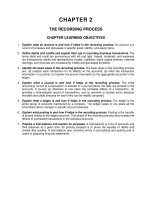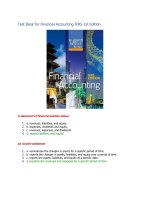Financial accounting IFRS 4 kieoso ch05 PPT
Bạn đang xem bản rút gọn của tài liệu. Xem và tải ngay bản đầy đủ của tài liệu tại đây (1.18 MB, 87 trang )
Financial Accounting
IFRS 4th Edition
Weygandt ● Kimmel ● Kieso
Chapter 5
Accounting for Merchandise Operations
Chapter Outline
Learning Objectives
LO 1
Describe merchandising operations and inventory systems.
LO 2 Record purchases under a perpetual inventory system.
LO 3 Record sales under a perpetual inventory system.
LO 4 Apply the steps in the accounting cycle to a
merchandising company.
LO 5 Prepare financial statements for a merchandising
Copyright ©2019 John Wiley & Sons, Inc.
company.
2
Learning Objective 1
Describe Merchandising Operations and Inventory Systems
Copyright ©2019 John Wiley & Sons, Inc.
3
Merchandising Operations and Inventory Systems
Merchandising Companies
Buy and Sell Goods
Retailer
Wholesaler
Consumer
The primary source of revenues is referred to as sales revenue or sales.
Copyright ©2019 John Wiley & Sons, Inc.
4
Merchandising Company
Income Measurement
Cost of goods sold is the total cost of merchandise
sold during the period.
Copyright ©2019 John Wiley & Sons, Inc.
5
Operating Cycles
Copyright ©2019 John Wiley & Sons, Inc.
6
Flow of Costs (1 of 4)
Companies use either a perpetual inventory system or a periodic inventory system to account for inventory.
Copyright ©2019 John Wiley & Sons, Inc.
7
Flow of Costs (2 of 4)
Perpetual System
•
Maintain detailed records of the cost of each inventory purchase and sale
•
Records continuously show inventory that should be on hand for every item
•
Company determines cost of goods sold each time a sale occurs
Copyright ©2019 John Wiley & Sons, Inc.
8
Flow of Costs (3 of 4)
Periodic System
•
Does not keep detailed records of goods on hand
•
Cost of goods sold determined by count
•
Calculation of Cost of Goods Sold:
Beginning inventory
€100,000
Add: Purchases, net
800,000
Goods available for sale
900,000
Less: Ending inventory
125,000
Cost of goods sold
€775,000
Copyright ©2019 John Wiley & Sons, Inc.
9
Flow of Costs (4 of 4)
Advantages of the Perpetual System
•
Traditionally used for merchandise with high unit values
•
Shows quantity and cost of inventory that should be on hand at any time
•
Provides better control over inventories than a periodic system
Copyright ©2019 John Wiley & Sons, Inc.
10
Do It! 1: Merchandising Operations and Inventory Systems
Indicate whether the following statements are true or false. If false, indicate how to correct the statement.
1.
The primary source of revenue for a merchandising company results from performing services
for customers.
2.
False
(service company)
The operating cycle of a service company is usually shorter than that of a merchandising
company.
3.
Sales revenue less cost of goods sold equals gross profit.
4.
Ending inventory plus the cost of goods purchased equals cost of goods available for sale.
Copyright ©2019 John Wiley & Sons, Inc.
True
True
False
(Beg. Inventory + COGS)
11
Learning Objective 2
Record Purchases Under a Perpetual System
Copyright ©2019 John Wiley & Sons, Inc.
12
Recording Purchases Under a Perpetual Inventory System
•
Made using cash or credit (on account)
•
Normally record when goods are received from the seller
ã
Purchase invoice should support each credit purchase
Copyright â2019 John Wiley & Sons, Inc.
13
Recording Purchases
Purchase invoice should
support each credit purchase
Copyright ©2019 John Wiley & Sons, Inc.
14
Record Purchase of Merchandise
Illustration: Sauk Stereo (the buyer) uses as a purchase
invoice the sales invoice prepared by PW Audio Supply,
Inc. (the seller). Prepare the journal entry for Sauk
Stereo for the invoice from PW Audio Supply.
May 4
3,800
Inventory
Accounts Payable
3,800
Copyright ©2019 John Wiley & Sons, Inc.
15
Freight Costs (1 of 2)
Ownership of the goods passes to the buyer when
Ownership of the goods remains with the seller
the public carrier accepts the goods from the seller.
until the goods reach the buyer.
Freight costs incurred by the seller are an operating expense.
Copyright ©2019 John Wiley & Sons, Inc.
16
Freight Costs (2 of 2)
Illustration: Assume upon delivery of the goods on May 6, Sauk Stereo pays Public Freight Company €150
for freight charges, the entry on Sauk Stereo’s books is:
May 6
Inventory
150
Cash
150
Assume the freight terms on the invoice on slide number 13 had required PW Audio Supply to pay the
freight charges, the entry by PW Audio Supply would be:
May 4
Freight-Out (or Delivery Expense)
150
150
Cash
Copyright ©2019 John Wiley & Sons, Inc.
17
Purchase Returns and Allowances (1 of 4)
Purchaser may be dissatisfied because goods are damaged or defective, of inferior quality, or do
not meet specifications.
Purchase Return
Return goods for credit if the sale was made on credit, or for a cash refund if the purchase was for
cash.
Purchase Allowance
May choose to keep the merchandise if the seller will grant a reduction of the purchase price.
Copyright ©2019 John Wiley & Sons, Inc.
18
Purchase Returns and Allowances (2 of 4)
Illustration: Assume Sauk Stereo returned goods costing €300 to PW Audio Supply on May 8.
May 8
300
Accounts Payable
Inventory
300
Copyright ©2019 John Wiley & Sons, Inc.
19
Purchase Returns and Allowances (3 of 4)
Review Question
In a perpetual inventory system, a return of defective merchandise by a purchaser is recorded by
crediting:
a.
Purchases
b.
Purchase Returns
c.
Purchase Allowance
d.
Inventory
Copyright ©2019 John Wiley & Sons, Inc.
20
Purchase Returns and Allowances (4 of 4)
Review Question
In a perpetual inventory system, a return of defective merchandise by a purchaser is recorded by
crediting:
a.
Purchases
b.
Purchase Returns
c.
Purchase Allowance
d.
Inventory
Copyright ©2019 John Wiley & Sons, Inc.
21
Purchase Discounts (1 of 5)
Credit terms may permit buyer to claim a cash discount for prompt payment.
Advantages:
•
Purchaser saves money
•
Seller shortens the operating cycle by converting the accounts receivable into cash earlier
Example: Credit terms may read 2/10, n/30.
Copyright ©2019 John Wiley & Sons, Inc.
22
Purchase Discounts (2 of 5)
2/10, n/30
2% discount if paid within 10 days, otherwise net amount due within 30 days.
1/10 EOM
1% discount if paid within first 10 days of next month.
n/10 EOM
Net amount due within the first 10 days of the next month.
Copyright ©2019 John Wiley & Sons, Inc.
23
Purchase Discounts (3 of 5)
Illustration: Assume Sauk Stereo pays the balance due of €3,500 (gross invoice price of €3,800 less
purchase returns and allowances of €300) on May 14, the last day of the discount period. Prepare the
journal entry Sauk Stereo makes on May 14 to record the payment.
May 14
Accounts Payable
3,500
Inventory
70
Cash
3,430
(Discount = 3,500 ì 2% = 70)
Copyright â2019 John Wiley & Sons, Inc.
24
Purchase Discounts (4 of 5)
Illustration: If Sauk Stereo failed to take the discount, and instead made full payment of €3,500 on June
3, the journal entry would be:
June 3
Accounts Payable
3,500
Cash
3,500
Copyright ©2019 John Wiley & Sons, Inc.
25









